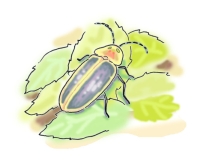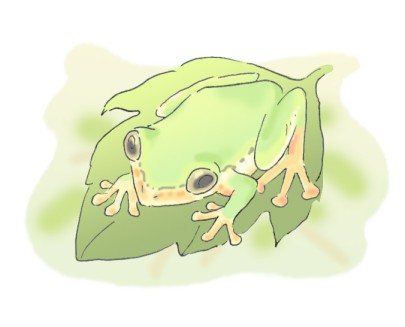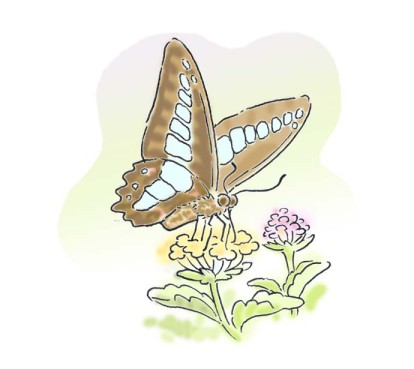

校園探索–在瑞柑
新北市自然科學輔導團團員 吳海獅
一、前言:
瑞柑原稱柑子瀨、苧子潭。今日,在地人稱「內瑞芳」,訴說著這個小聚落由農業、商業、礦業的一段人文歷史,從樸實(農業)到旅人絡繹於途(商旅),甚至人聲鼎沸時期(礦業),現在則呈現人口縮減而歸於閒靜的小村落。瑞柑國小剛過五十週年校慶(1963∼2014),原因應煤礦開採村落人口驟增而增設,屬中型學校規模。今日,隨著礦業衰微人口外移,已是六班的小型學校。瑞柑國小校園身處山間谷地,四周被幾座小山包圍著,學生年年更迭,校園環境也隨著季節而換上不同的裝扮,若能定期拜訪,總有按照時序出現的各式各樣自然生態,熱誠地迎接訪客。這是一個自然天成的生態樂園,可以提供體驗、觀察、探索與研究的學習園地。
![]()
二、淺談瑞柑聚落發展歷程
瑞芳產煤和金,金集中在九分、金爪石及牡丹三地,煤則平均分布各區。金礦乃基隆河淘取沙金沿河而上而發現,煤則因探勘猴洞、四腳亭兩大煤田而開採,金煤都在清末1890以後才大量開採,又因1895台灣割據日本,受殖民地經濟政策下,礦業機能迅速投入原農業聚落體系。礦業是一種需要技術及大量人力產業,往往一個礦坑就可形成一個小聚落,靠得就是煤礦開採所帶來的經濟效應。
柑子瀨原為瑞芳行政中心所在地,日據初期仍為人口不多的農業聚落,1915有716人,1930也僅784人。尤以1924宜蘭線鐵路全線開通,本地因平地太小,火車站設於今日瑞芳地區,1930行政中心也移至瑞芳,柑子瀨被稱為「內瑞芳」訴說著一段歷史沿革。
採金盛期1930∼1941,光復後已趨衰退,採煤盛期1951∼1971,則在光復後民國四十∼六十年間,台灣採煤以民國五十五年為最盛期,以前屬成長期,此年已呈現由頂峰而開始衰退的趨勢。
瑞柑因懷山煤礦而形成一個純礦業聚落,其從事煤礦人口佔有75%∼100%比例,加上因煤礦業急劇衰退,使得聚落呈現急遽變動的型態,懷山煤礦為瑞柑聚落主坑所在,其產業興衰連動著聚落的發展。煤礦興盛期,曾經養活數千人,民國六十年代以後,煤礦漸漸封坑,支持聚落的主要經濟動能也宣告消失。
瑞柑聚落慢慢呈現停滯老化的現象,礦工子弟或移遷出去,或外出打拚,留下老幼顧守家園。近年來,社會經濟不振,少子化等因素影響下,聚落各項活動更顯老邁缺乏朝氣。瑞芳礦業山城觀光業日見興盛,或能為本地注入新的動能,活絡聚落經濟。

三、瑞芳公園–大自然回春圖
懷山煤礦現址已闢建為瑞芳公園,昔日景像已難復見。可想像當時環境光景,採礦機器如絞盤車,電器場、運轉場、澡堂等,所及之處一片焦黑喧譁,卻又燈火通明廿四小時營業,對瑞芳山區自然生態想必是一場浩劫,當時也少有人會去關心山上的情況,礦業乃最現實的生產事業。
民國六十年代迄今,礦坑封了,原址改建為瑞芳公園,遮去過往時期驚天動地山林蒙塵景像。慶幸的,瑞芳山系得到了幾十年的喘息機會,冷冽東北風、連綿陰雨及當空烈日,是這大自然的正常模式。當大自然得到生養滋息的機會時,回饋是快速而豐厚的。誰料知鐘萼木竟在1981才被發現,而瑞芳山區又存在相當多的族群,紅淡比、野鴉椿、虎皮楠、烏皮九芎等代表性樹種,通通集合到這片小小的山地,植被豐富了,當然動物也多了起來,蝴蝶、青蛙、螢火蟲按照季節一一亮相。
瑞柑國小得天獨厚,校園兩個生態村就有十餘種蛙類,整年都可看到它們的身影,聽到它們美妙的鳴叫聲;四月的暮色中,火金姑照亮著這裡的山谷;蝴蝶則在天氣放晴飛滿校園。今日,統合整座瑞芳公園後,瑞柑的校園生態資源更是如虎添翼,足供各領域特色課程之發展。



![]()
四、瑞柑生態教學資源初探與應用
瑞柑擁有瑞芳山系(龍潭山、瑞芳山、秀崎山)豐富的自然生態資源,總有蛙、蝶、各種小動物進到教室要和小朋友一起上課。當走出教室時,花香撲鼻而來;山棕花是濃烈的甜香,樹杞花則隨風送來陣陣清香,紅淡比花帶來幽雅脫俗的馨香;大自然以她的芬芳深深吸引瑞柑師生迫不及待地投入她的懷抱。操場寬廣平坦的青青草地,可躺可臥,小朋友趴下來傾聽地球的心跳,化身為螞蟻和土中小動物,感受它們眼裡的世界長的什麼樣子。樹是大地的守護神,小朋友喜歡親近她擁抱她,觀察研究來多瞭解她,祈求她永遠的照護。
 |
 |
|
圖一:五月紅淡比花開 |
圖二:山棕花濃香撲鼻 |
 |
 |
|
圖三:傾聽大地心跳 |
圖四:土中小動物看世界 |
 |
 |
|
圖五:聽聽樹媽媽的心跳 |
圖六:小動物眼中的世界 |
走上瑞芳公園步道,瑞柑民生三寶列隊迎接大家;八芝蘭竹告示昔日漢人在這裡闢墾的痕跡,魚腥草是老祖母的私房草藥,而相思樹則是採煤礦時期,用來支撐坑道保護礦工的安全;小朋友學到了植物如何福利民生的意義,大自然要愛護大家才有好日子。瑞芳公園是眾多動物的家,松鼠、黑鳶、青竹絲和蝶螢蛙等都是這裡的原住民,它們共同組成一個生意盎然的樂園。小朋友發現有些樹特別受到昆蟲們的青睞,在每片水金京葉子上幾乎都可看到奇怪的咬痕,仔細看,不只一種咬痕,一種棕色小圓斑佈滿葉面,只有葉子表層被啃食掉,還留下薄薄一層的表皮,是誰有這麼厲害的啃功?觀察到這是棕長頸捲葉象鼻蟲用它的口器刮食的傑作,在山桂花、臭黃荊葉片上也都看到這種刮痕。
 |
 |
|
圖七:象鼻蟲刮食樹葉 |
圖八:象鼻蟲刮食遺痕 |
同一張水金京葉子上的另一種食痕則是由葉緣往葉身咬食的凹洞,這是單帶蛺蝶幼蟲的咬痕,在同一張葉子上可以發現多種咬痕,讚嘆水金京身藏玄機,竟然是一位超級奶媽,養大好多好多子民。棕長頸捲葉象鼻蟲媽媽還會捲起水金京葉子,然後在裡面下一顆卵,它的幼蟲就在捲葉裡吸食汁液直到成蟲,換句話說,一隻捲葉象鼻蟲有兩個奶媽把它養大的。小朋友從植物和小動物互動關係上,建構了第一手的生態系統資料,從而深入瞭解生命之值得尊重與珍惜的本質。
 |
 |
|
圖九:水金京開花 |
圖十:小朋友描繪水金京葉咬痕 |
瑞芳公園步道最高處由龍潭山、瑞芳山與秀崎山串起的一條天際陵線,北望深澳灣,南看基隆河。站在山頭可領受從洋面長驅直入的東北季風,冷峻而潮濕,夏季太陽下,則熱燥難耐,若加上颱風來襲,強風暴雨肆虐,生長在山頭迎風面的植物,想必得承受得住這樣水深火熱的氣候,才能生存下來,因而造就一群堅守陵線的山頂守護神如:野鴉椿、大明橘、臭黃荊、青剛櫟、烏皮九芎、紅淡比、賊仔樹和饅頭果等樹種,各自展現無比堅韌的生命力,守在山頭方寸之地,護衛著瑞柑學子。
 |
 |
|
圖十一:饅頭果結果 |
圖十二:大明橘結果 |
 |
 |
|
圖十三:臭黃荊開花 |
圖十四:野鴉椿結實纍纍 |
駐立山頭的鐘萼木是瑞芳公園最具特色的物種,身形堅韌不畏強風烈日,大串鐘形花綻開引人佇足,葉子更是輕海紋白蝶食草,五月是欣賞滿山滿谷飛蝶的季節,為瑞柑憑添另一項精彩的自然景觀。山不在高,有蛙螢蝶縈繞就很美。
 |
 |
|
圖十五:在瑞芳山上學習 |
圖十六:瑞芳公園步道行進中 |
 |
 |
|
圖十七:鐘萼木佇立山頭 |
圖十八:鐘萼木粗壯枝葉 |
 |
 |
|
圖十九:輕海紋白蝶 |
圖二十:輕海紋白蝶交配中 |
![]()
四、結語
瑞柑聚落歷經農商礦興衰變化,今日雖失去產業經濟動能,但恢復了山林原有自然生態風貌,猶如浴火鳳凰再展英姿。瑞柑校園受益於周圍山林復甦,造就這一片鳥語花香蟲鳴鳥叫絕美的生態學園,師生有福得以在豐富的自然生態環境中學習。現在,準備跨出校園,納入整個瑞芳公園為教學園地,提供學生最大值的山林田野學習內涵,建置校本特色課程,落實生態保育學習,從大自然提供的素材完滿學習,大地也從人的回饋中得到保育實務而永續發展。
![]() Exploring
the Campus of Ruigan Elementary School
Exploring
the Campus of Ruigan Elementary School
土城國小張凱復
introduction
Formerly known as Ganzilai or Zhuzitan, Ruigan is nowadys called Inner Ruifang by local people reminding us of the transformation from rural agriculture, travel business, to once prosperous mining industry. Now, Ruigan has turned into a peaceful small village because of falling population. Ruigan Elementary School, just celebrated her 50th anniversary, established in accordance with the population that came along with the coal mining village was originally a middle scale school but now has only six classes. Located in the valley, surrounded by several hills, Ruigan Elementary School changes her beautiful costumes with seasonal pace welcoming all the visitors. This is a natural biological garden providing opportunities to experience, observe, explore and to study.
The development of Ruigan
Ruifang had gold and coal mines. The gold mines were found in Jiufen, Jinguashi and Mudan while the coal mines in every area. The gold was found while panning gold in River Keelung downstream. Then, the gold and coal mines were massively unearthed in late 1890s, Qing Dynasty. Moreover, in 1895, Taiwan was ceded to Japan. Influenced by the colonial economy policy, the mining mechanisms soon merged with original agriculture economic systems. Mining was a technique and human resources intensive industry. A small village could be formed nearby the mine under the economic influence of mining.
Ganzilai was originally the administration center of Ruifang. In early Japanese ruling era, Ganzilai was an agricultural village with few population, 716 people in 1915 and 784 people in 1930. After the completion of Yilan line railroad in 1924 but without spacious hinterland, the station was established in Ruifang. Consequently, the administration center was moved to Ruifang. The old name of Ganzilai, Inner Ruifang has told us the history.
The gold rush reached its peak from 1930 to 1941, while the coal from 1951 to 1971. Now the prosperity is no longer to see.
Ruigan village was formed by Huaishan coal mine. There were 75 to 100 percent of population earned their lives on mining. Rapid recession took place when the coal mine exhausted. The major economic diminished gradually after 1970 and finally disappeared.
Ruigan village has been withering. Many offsprings of miners emigrated or sought for better job offers outward and left the old and young generation home. Recently, due to economic recession and low birth rate, the vitality has much more weakened. Hopefully, the prospering touring business can add some fresh air to the village and revive the economy.
Ruifang Park—a rejuvenescence of Mother Nature
Huaishan coal mine has now turned into Ruifang Park. The old scenery was gone. Imaging the hustling and bustling during that time, mining machines and the burned blackness were every where while the lights ceaselessly illuminated. It was undoubtedly a catastrophe for the biology of this mountain area. Fewer concerns were drawn at that time. Mining could be a very utilitarian business.
After the closing of the mine in 1970s, Ruifang Park made the dusty scenes out of sight. Moreover, Ruifang ranges could catch a deep breath. The frozen northeast wind, continuous rain and burning sun are the pulses of Mother Nature. When Mother Nature gets her nutrients, fertility and productivity are granted. One could never tell that not until 1981 was Chinese Bretschneidera to be found in this area. Also many other kinds of trees can be seen in these mountains. Animals have been increasing with the varieties of trees.
With the nature advantages, Ruigan Elementary School has more than 10 sorts of frogs. People can see and hear the frogs around the year. In April dusks, fireflies light up the valleys. And butterflies fly here and there on the campus on sunny days. Ruigan Elementary School can make the best of her resources to develop character curriculum.
The introduction and application of Ruigan biological teaching resources
Ruigan is surrounded by Reifang ranges and their abundant natural biological resources. It is quite common to have those frogs, butterflies and other animals in class. The sweet aroma of the flowers enchants the students as well as teachers to bathe in the attractive atmosphere. On the grass-covered play ground, children can lie down and listen to the heart beats of the earth pretending to be ants or little animals in the soils and experiencing the world in the insects’ points of view. The trees are the guardians of the planet. Children like to approach them to understand and study them praying for their great protection.
Wandering on the path of Ruifang, three unique plants Park could be seen. Bambusa Pachinensis shows the sign of Han people’s cultivation. Houttuynia cordata is grandmas’ medical herb. People once used Acacia confusa to sustain the structure of mine tunnels. Children can learn how these plants are beneficial to our daily life. We have to cherish our environments to survive.
Ruifang Park is also the home to many animals, such as squirrels, eagles, snakes and frogs. These animals are the aboriginal habitants here and organize a vigorous park. Children can notice that some trees could catch insects’ attention more easily. That is Wendlandia formosana. Leaves of Wendlandia formasana are bitten by various kinds of insects, especially Paratrachelophorus nodicornis. The mother laid an egg on a leaf and rounded it to be food as the larva grows. Through observation of the interaction between plants and insects, children can learn the first hand knowledge. They can furthermore understand and respect the essence of life.
Ruifang Park path connects Mt. Longtan, Mt. Ruifang and Mt. Showchi with Shenao Bay in the north, Keelung river in the south. Standing on the mountain top, people can feel the cold and damp northeast wind blow. While it is extremely hot under the summer sun. Unavoidable typhoons striking, harsh wind and heavy rain bombarding, the plantation needs to be strong enough to sustain and survive the weather. As a result, the plantation here demonstrates a great vitality to shelter the students of Ruigan.
The most unique species is Chinese Bretschneidera. They can tolerate with severe weather. Their flowers are beautiful. Their leaves are food to butterflies. People can see thousands of butterflies in May which is another marvelous scene of Ruigan.
Conclusion
Ruigan village had experienced her prosperity and downfall, lost her economic attraction, but regained her natural beauty just like a phoenix returned from ashes. Ruigan Elementary School has been granted such abundant biological resources. Now, let us integrate the curriculum with the nature elements to construct the school-based characteristic courses and practice biological preservation learning. We can pursue an everlasting development from these related experiences.